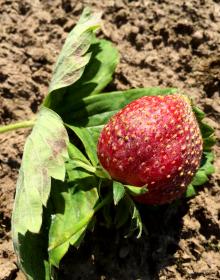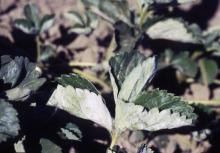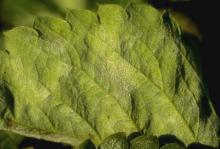See:
Strawberry Cultivar Susceptibility
Cause Podosphaera aphanis var. aphanis (formerly Sphaerotheca macularis f. sp. fragariae), a fungus that overwinters on infected plant tissue including living leaves. This fungus is favored by conditions that produce high humidity (>75%) but dry leaves. Conidia are able to begin germination after 6 hours and complete it within 24 hours, irrespective of temperature. Rain or irrigation inhibit spore germination and colony development. Lesion expansion is related to temperature but does not seem to be related to relative humidity. Only the youngest leaf or fruit tissue is susceptible to infection. As leaves and fruit age they rapidly become resistant to infection. Spore germination, hyphal growth, haustoria formation, colony expansion, and sporulation are all reduced while the latent period increases as the plant tissue matures. Cultivars with leaves that emerge folded generally have more disease on the underside of the leaf as it is exposed to inoculum while susceptible. The upper surfaces are exposed to inoculum as they become more resistant to infection. Fruit becomes resistant to infection 10 to 15 days after bloom (about white stage). Mild water stress reduced spore germination and disease severity. High tunnel production of strawberry has been particularly favorable to disease development.
Powdery mildew fungi are highly specialized pathogens that form a close association with the host. Conditions that favor the host also favor the pathogen. Much of the fungus remains outside infected plant parts where it grows on the surface but sinks root-like structures called haustoria into plant cells to obtain nutrients. The white growth seen is composed of both mycelium and fungal spores. Cleistothecia may form within the colonies late in the growing season, stay associated with the overwintering leaves and shed mature sexual spores in the spring when plant growth resumes.
'Hood', 'Totem', and 'Benton' are moderately resistant or tolerant to mildew; 'Shuksan', 'Sumas', and 'Linn' are moderately susceptible; 'Olympus', 'Redcrest', 'Independence', 'Puget Summer', 'Firecracker', 'Whonnock' and 'Northwest' are very susceptible. Day-neutral cultivars are more susceptible to powdery mildew. The powdery mildew of raspberry does not infect strawberry and that of strawberry does not infect raspberry despite the similar name.
Symptoms Edges of infected leaflets curl up, exposing undersides that often are reddened and coated with a grayish-white powdery fungal growth. Diseased leaves later turn purplish or red. In irrigated fields, the fungus also may attack fruit. Some day-neutral cultivars are susceptible to fruit infection in fall even though leaves may appear healthy. Leaf curl due to powdery mildew may be mistaken for water stress symptoms.
Cultural control
- Destroying old leaves by renovating plants after harvest may help reduce inoculum.
- Plant resistant cultivars.
- Frequent overhead irrigation for short periods may help remove conidia and reduce disease pressure. Do not irrigate such that leaves are wet for extended periods of time. Midday water mists applied in pulses lasting 1 min each four times per day with rapid drying has been effective for greenhouse or high tunnel production.
- Nighttime applications of ultraviolet light (UV-C) either once or twice weekly has been shown to suppress powdery mildew on leaves and fruit.
- Airated steam at 104°F to 111°F for 2 to 4 hours was effective on pre-heated strawberry transplants.
Chemical control The disease needs to be controlled on highly susceptible cultivars after summer renovation so plants remain vigorous until they cease growth and go dormant in late fall. Powdery mildew on most cultivars grown in the PNW does not seem to impact yield the next year. Therefore, growers have not typically managed this disease after harvest. Many of these products, such as soaps, oils and sulfurs, may influence mite problems in the field. Some could influence gray mold fungicide resistance. Alternate or tank-mix products from different groups that have different modes of action. Resistance and/or reduced sensitivity has been reported for all fungicides active against strawberry powdery mildew including FRAC groups 3, 7, 11, 13 and U6. Selection of products for rotation and/or mixing must consider group 7 fungicides when used through the irrigation as a nematicide.
- Abound at 6 to 15.5 fl oz/A. Do not apply with silicone-based surfactants. May be applied on the day of harvest. Group 11 fungicide. 4-hr reentry.
- Affirm WDG at 6.2 oz/A. Can be used in structures but not open fields. Group 19 fungicide. 4-hr reentry.
- Aftershock at 2 to 5.7 fl oz/A. Do not apply within 1 day of harvest. Group 11 fungicide. 12-hr reentry.
- Bicarbonate-based products. Might supplement a normal program when powdery mildew is first observed. Do not mix with acidifying agents. Thorough coverage is essential. Easily washed off by rain, so reapplication is necessary. O
- Kaligreen (82% potassium bicarbonate) at 2.5 to 3 lb/A. 4-hr reentry.
- MilStop (85% potassium bicarbonate) at 2.5 to 5 lb/A.
- Oregon and Washington only. 1-hr reentry.
- Monterey Bi-Carb Old Fashioned Fungicide at 4 teaspoons/2 gal water. H
- Cabrio EG at 12 to 14 oz/A. May be used at harvest. Group 11 fungicide. 12-hr reentry.
- Cevya at 5 fl oz/A. May be used day of harvest. Group 3 fungicide. 12-hr reentry.
- Cinnerate at 16 to 64 fl oz/100 gal water plus an adjuvant. 4-hr reentry. O
- EcoSwing at 1.5 to 2 pints/A. Can be used day of harvest. Group BM01 fungicide. 4-hr reentry. O
- Evito 480 SC at 2 to 5.7 fl oz/A. Do not use within 1 day of harvest. Group 11 fungicide. 12-hr reentry.
- Flint Extra at 2.5 to 3 fl oz/A. May be applied up to the day of harvest. Group 11 fungicide. 12-hr reentry.
- Fontelis at 16 to 24 fl oz/A. Can be used day of harvest. Foliar reddening or speckling may occur in some cultivars. Do not use if already used for gray mold control. Group 7 fungicide. 12-hr reentry.
- Fracture (BLAD) at 20.5 to 24.4 fl oz/A. Reapply if rain occurs within 12 hours of original application. Do not use within one day of harvest. Group BM01 fungicide. 4-hr reentry.
- Gatten at 6 to 8 fl oz/A. Can be used day of harvest. Group U13 fungicide. 12-hr reentry.
- Horticultural Mineral Oils. Generally effective from 1% to 2% volume to volume. Necrotic foliage may result if applied within 10 days of any sulfur application. Do not tank-mix with copper-based products when fruit is present. Do not use during freezing temperatures, above 90°F, or when plants are under heat or moisture stress. Do not use when foliage is wet because good coverage is essential. 4-hr reentry. O
- JMS Stylet Oil at 3 quarts/100 gal water.
- SuffOil-X at 1 to 2 gal/100 gal water.
- Inspire Super at 16 to 20 fl oz/A. Can be applied day of harvest. Group 3 + 9 fungicide. 12-hr reentry.
- Kenja 400 SC at 13.5 to 15.5 fl oz/A. May be used up to and including day of harvest. Do not use if already used for gray mold control. Group 7 fungicide. 12-hr reentry.
- Luna Sensation at 4 to 7.6 fl oz/A. May be use day of harvest. Do not use if already used for gray mold control. Group 7 + 11 fungicide. 12-hr reentry.
- Luna Tranquility at 16 to 27 fl oz/A. Do not use within 1 day of harvest. Group 7 + 9 fungicide. 12-hr reentry.
- Merivon at 4 to 7 fl oz/A. Do not use with EC or oil-based products. May be used day of harvest. Do not use if already used for gray mold control. Group 7 + 11 fungicide. 12-hr reentry.
- Mettle 125 ME at 3 to 5 fl oz/A. May be applied on the day of harvest. Do not use if used for gray mold control. Group 3 fungicide. 12-hr reentry.
- Miravis Prime at 11.4 to 13.4 fl oz/A. May be used day of harvest. Do not use if already used for gray mold control. Group 7 + 12 fungicide. 12-hr reentry.
- M-Pede at 1 to 2 gal/100 gal water. Good coverage is essential. Do not use within 3 days of applying sulfur. Do not mix with hard water. 12-hr reentry. O
- Oso SC at 6.5 to 13 fl oz/A. May be applied on the day of harvest. Group 19 fungicide. 4-hr reentry. O
- Ph-D WDG at 6.2 oz/A plus an adjuvant. May be applied on the day of harvest. Group 19 fungicide. 4-hr reentry.
- Prev-Am at 50 fl oz/100 gal water. Do not use above 90°F or when plants are under heat or moisture stress. 24-hr reentry.
- Problad Verde at 18.1 to 45.7 fl oz/A. Reapply if rain occurs within 12 hours of original application. Do not use within one day of harvest. Group BM01 fungicide. 4-hr reentry.
- Pristine at 18.5 to 23 oz/A. Can be used day of harvest. Do not use if used for gray mold control. Group 7 + 11 fungicide. 12-hr reentry.
- Procure 480 SC at 4 to 8 fl oz/A. Do not apply within 1 day of harvest. See label for crop rotation restrictions. Group 3 fungicide. 12-hr reentry.
- Propiconazole-based fungicides are registered. May be applied day of harvest. Group 3 fungicides.
- Bumper 41.8 EC at 4 fl oz/A. 12-hr reentry.
- PropiMax EC at 4 fl oz/A. 12-hr reentry.
- Tilt at 4 fl oz/A. 24-hr reentry.
- Prolivo 300 SC at 4 to 5 fl oz/A. Can be used day of harvest. Group 50 fungicide. 4-hr reentry.
- Quadris Top at 12 to 14 fl oz/A. May be applied on the day of harvest. Group 3 + 11 fungicide. 12-hr reentry.
- QuiltXcel at 14 fl oz/A. May be used the day of harvest. Group 3 + 11 fungicide. 12-hr reentry.
- Quintec at 4 to 6 fl oz/A. A surfactant is not required when used alone but a nonionic surfactant is preferred if needed for tank-mixes. Do not apply within 1 day of harvest. May cause leaf spotting and chlorosis under certain conditions. Group 13 fungicide. 12-hr reentry.
- Rally 40 WSP at 2.5 to 5 oz/A. Can apply up to the day of harvest. Group 3 fungicide. 24-hr reentry.
- Regalia at 1 to 4 quarts/A. Use on 7-day intervals. May be used day of harvest. Does not benefit from the addition of an adjuvant. Group P5 fungicide. 4-hr reentry. O
- Regev at 4 to 8.5 fl oz/A. Do not apply within 2 days of harvest. Group 3 + BM01 fungicides. 12-hr reentry.
- Rhyme at 5 to 7 fl oz/A foliar or at 7 fl oz/A through a drip system. May be applied day of harvest. Group 3 fungicide. 12-hr reentry.
- Torino at 3.4 oz/A. May be used day of harvest. Group U6 fungicide. 4-hr reentry.
- Sil-Matrix at 1 to 4 quarts/100 gal water plus a nonionic surfactant. Can be applied up to the day of harvest. 4-hr reentry. O
- Spectracide Immunox Multi-Purpose Fungicide Spray Concentrate for Gardens at 1.25 fl oz/gal water. May be applied up to the day of harvest. Do not apply more than six (6) times per season. Group 3 fungicide. H
- Sulfur products. Do not extend intervals beyond 14 days. Sulfur can burn foliage when applied above 85°F. The temperature relationship is correlated with increases in the daily maximum, within a few days after application. Trials in Florida high tunnels found that minimal damage was observed only at temperatures above 95 F for at least 2 hr. Do not use within two weeks of an oil spray. Group M2 fungicides. 24-hr reentry. O
- Microthiol Disperss (80% sulfur) at 5 to 10 lb/A. Do not use a spreader-sticker. Use at 7- to 14-day intervals.
- Safer Brand Garden Fungicide (12% sulfur) at 2 fl oz/gal water thoroughly sprayed over the entire plant. Do not use on fruit that will be used for canning or within 1 day of harvest. H
- Thiolux (80% sulfur) at 5 to 10 lb/A.
- Tesaris at 3.4 to 5.7 fl oz/A. Do not use with oil based products. May be used day of harvest. Group 7 fungicide. 12-hr reentry.
- Topguard EQ at 5 to 8 fl oz/A. Do not use with silicone surfactants. May be applied on the day of harvest. Sprayers should not be used on apples. Group 3 + 11 fungicide. 12-hr reentry.
- Trionic 4 SC at 4 to 8 fl oz/A. Do not apply within 1 day of harvest. See label for crop rotation restrictions. Group 3 fungicide. 12-hr reentry.
- Velum Prime at 6 to 6.5 fl oz/A can be used with drip, trickle of micro-sprinklers. May be applied day of harvest. Do not use if already used for gray mold control. Group 7 fungicide. 12-hr reentry.
Notes: Some registered products offer only suppression of this disease and thus are not recommended for use. These products include Double Nickel 55, Intuity, Sonata, and Vacciplant.
Forecasting The Gubler-Thomas (UC-Davis) program modified by Broome uses only temperature during the summer to predict conidial infection periods. This has been useful in California and may be of use in the PNW.
Biological control
- Aviv (Bacillus subtilis strain IAB/BS03) at 10 to 30 fl oz/100 gal water. Unknown efficacy. Preharvest interval not specified. 4-hr reentry. O
- Howler Evo (Pseudomonas chlororaphis strain AFS009) at 20 to 120 oz/A plus a surfactant. Can be used day of harvest. 4-hr reentry. O
- LifeGard WG (Bacillus mycoides isolate J) at 4.5 oz/100 gal water. Does not have direct activity on pathogens but stimulates host defenses. Unknown efficacy. 4-hr reentry. O
- Serenade OPTI (Bacillus subtilis strain QST 713) at 14 to 20 oz /A. Active ingredient is a small protein. 4-hr reentry. O
- Theia (Bacillus subtilis strain AFS032321) at 1.5 to 5 lb/A. May be applied up to and including the day of harvest. 4-hr reentry. O
References Rossi, F. G., Asalf, B., Grieu, C., Onofre, R. B., Peres, N. A., Gadoury, D. M. and Stensvand, A. 2020. Effect of Water Stress on Reproduction and Colonization of Podosphaera aphanis of Strawberry. Plant Disease 104:.2973-2978.
Onofre, R. B., Gadoury, D. M., Stensvand, A., Bierma, A., Rea, M. S. and Peres, N. A., 2021. Use of Ultraviolet Light to Suppress Powdery Mildew in Strawberry Fruit Production Fields. Plant Disease, 105:2402-2409.




